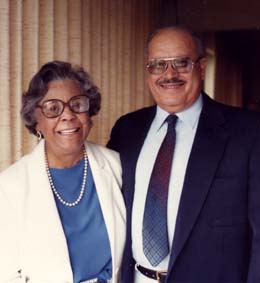This oral history of Arline and Letcher Yarbrough concerning racism during World War II in Seattle and at Fort Lewis was conducted at the Museum of History & Industry (MOHAI) on January 26. 1985, and is edited by MOHAI historian Dr. Lorraine McConaghy.
Racism on the Wartime Homefront
Arline Yarbrough: Before the war, it seems to me that most of the smaller restaurants in Seattle -- the soda fountains in drugstores and places like that -- did not practice any discrimination. Because of that, an experience I had during the war was very bitter. I was looking for a job, and I had to wait a while for the time of my appointment. I stopped in a little -- oh, I think it probably would be called a sandwich shop. They served sandwiches and soft drinks and that sort of thing. It was a very warm day, and I stopped in there for something cool to drink. I sat at the counter and waited, and eventually was told, We don’t serve you here.
I said, What do you mean, you don’t serve me?
A man came forward and said, We don’t serve Negroes.
It came as quite a shock to me because I had not experienced that in Seattle. We knew some of the bigger places were you were not going to be welcome in the first place, and we avoided them. But to stop in a little place like that -- well, that had never happened to me here.
Question: Would you say that Seattle became more racist during World War II?
Arline Yarbrough: Yes, and I think that these people who came up during the influx from the South brought their patterns with them.
Letcher Yarbrough: Both white and black.
Arline Yarbrough: They had set up their little restaurant, and they were discriminating.
Letcher Yarbrough: But by and large, the black community was very home-oriented. We invited neighbors and acquaintances into our own homes for dinner, rather than to go restaurants. And the same way with our parties. None of the dance halls would allow Negroes in the downtown dance halls, so we just didn’t go to them.
Question: Like the Trianon?
Letcher Yarbrough: Like the Trianon and the Encore, or the Hippodrome, at Fifth [Avenue] and University [Street, in downtown Seattle]. We were not welcome there and as a result there was no point in going there ... As my wife said, yes, discrimination did get worse during World War II because at that time both the blacks and the whites were coming from the South and other parts of the country where discrimination was practiced very blatantly. Blacks "knew their place," so to speak, and the whites enforced it ... I had a very unusual experience when I was drafted into the Army. I went out to Fort Lewis for my indoctrination, and when the fellow was writing it up, he put down “white” for me.
I told him, Look, I’m not white.
He said, Well, you look white to me.
I said, No, I’m a Negro.
So he scratched out “white” and wrote in “Negro,” and I went to a segregated Negro outfit. I ended up in a truck company, and we operated out of Camp Murray, adjacent to Fort Lewis.
One evening, two or three of us wanted to go over to the base theater at Fort Lewis, and we went in. I sat down, along with another fellow that was with me, and pretty soon the usher came down with his little flashlight like most ushers carry in a theater. He said, I’m sorry, you can’t sit here. I said, Why? Is this reserved? He said, No, but it says blacks have to sit at the back of the theater. Well, he actually said, Negroes have to sit at the back of the theater -- we were Negroes in those days. He said, Negroes have to sit at the back of the theatre. I said, This IS the U.S. Army theater, isn’t it?
He said, Yes.
And I said, Well, I’m not moving.
And he said, Well, then we’ll have to call an M.P. to put you out.
I said, Go ahead and call the M.P. I’m not moving. So they called the M.P. and he came down, and I told him, You’re going to have to arrest me if you want me to move. You’d better check with the N.C.O., if that’s the way you want to go.
So he took my name, rank and serial number, and I still didn’t move. Two days later, one of the post chaplains, who was black, came over to my commanding officer, who was white. The chaplain told my commanding officer what had happened, and they called me in. I said to them, If I’m going to lose my stripe -- because I was a sergeant then -- I’d just as soon lose it over something like this rather than lose it for going AWOL or something like that. My officer said, You won’t lose your stripes, but he called all of us to a meeting one morning at reveille, first thing in the morning. And he told us then that this was something he did not believe in, but that he had to obey orders from the Post Commander. He told us, I don’t believe in this, but if you go over there and don’t sit in the back where they tell you to, I can’t help you. Why don’t you, he went on, just quit going to the theater altogether, and that way, you won’t be embarrassed?
So we did. We stopped going to the base theater altogether ....

